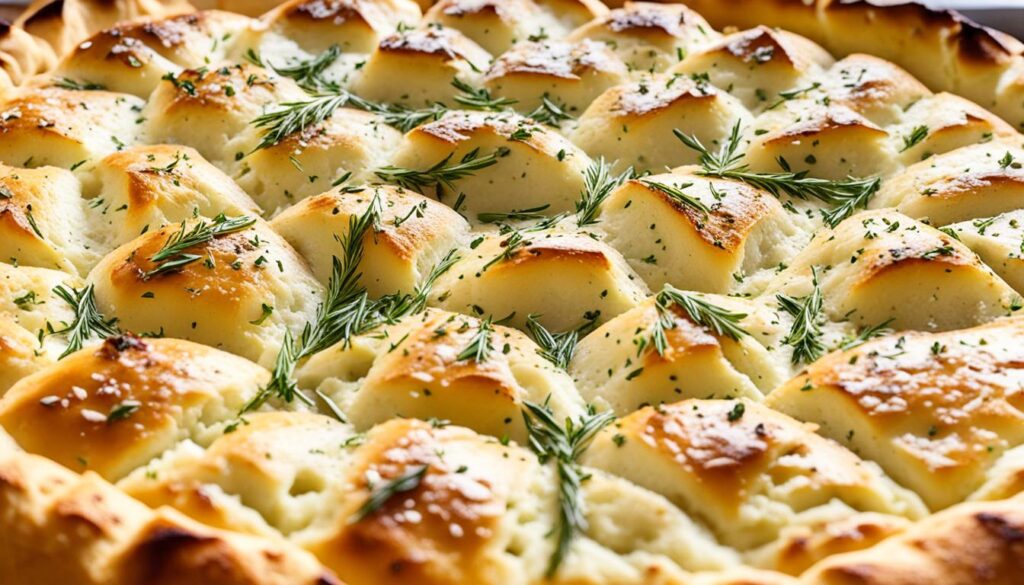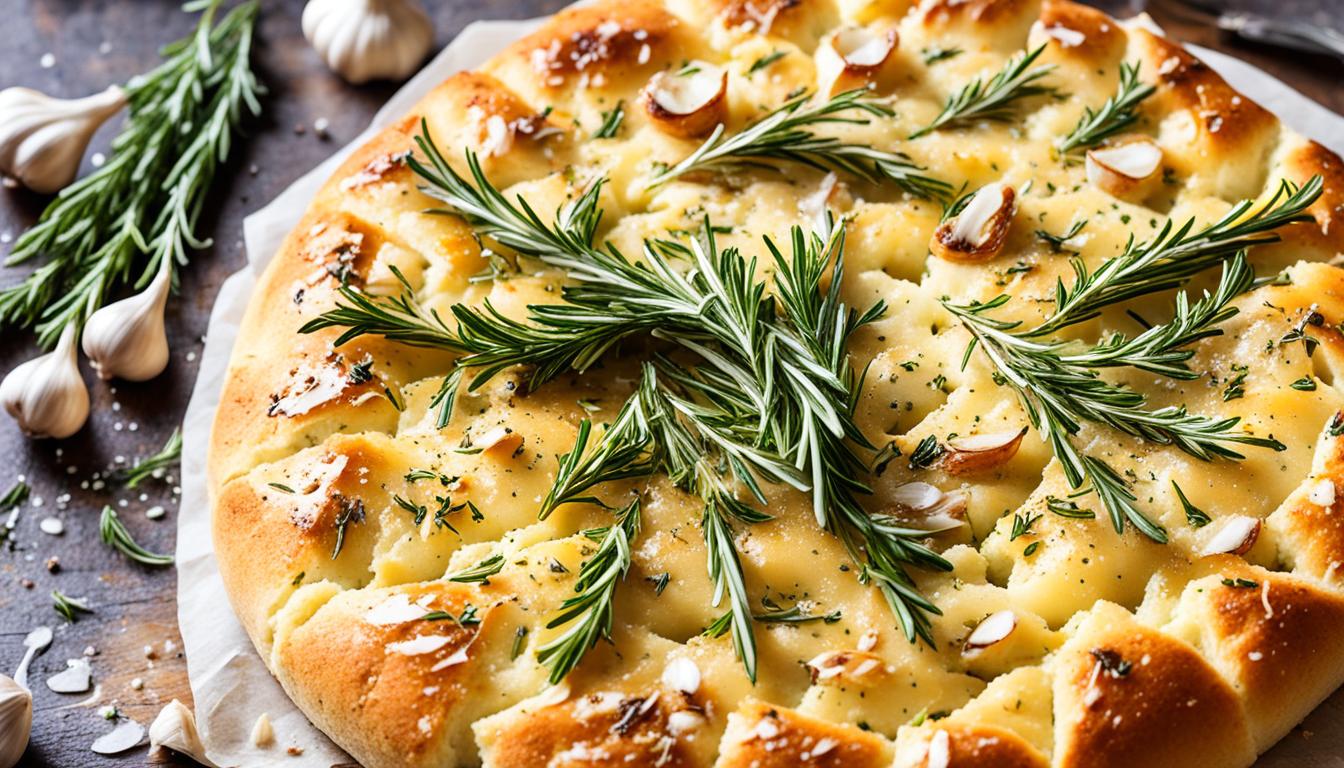Did you know that the average American consumes over 17 pounds of bread annually? While much of that is likely processed and store-bought, we believe there’s nothing quite like the satisfaction of baking your own artisanal loaf at home. That’s why we’re excited to share this easy roasted garlic focaccia no knead bread recipe – the perfect weekend baking project that yields a crusty, aromatic loaf bursting with garlic flavor.
The no-knead method requires minimal effort to produce bread with a great crumb. The recipe starts by roasting a whole head of garlic, then incorporating the sweet, tender garlic cloves directly into the dough. A basic no-knead formula made with bread flour, yeast, salt, and water is left to rise overnight, resulting in a bubbly, well-developed gluten structure. The dough is then dimpled and baked at a high temperature to create a crisp, golden-brown crust. While the bread bakes, a quick garlic butter is prepared to drizzle over the top, adding an extra layer of garlicky goodness.
This easy roasted garlic focaccia no knead bread recipe is the perfect weekend baking project that yields a crusty, aromatic loaf bursting with garlic flavor. The no-knead method requires minimal effort to produce bread with a great crumb, making it an excellent choice for both novice and experienced bakers alike. Whether you’re in the mood for a rustic Italian bread, a crusty bread baking project, or a simple homemade focaccia dough, this recipe is sure to satisfy your cravings and impress your friends and family.
Unlocking the Secrets of No-Knead Bread
The key to the no-knead bread method is that it allows gluten to develop with minimal effort. Normally, gluten is created by kneading the dough, which forces the glutenin and gliadin proteins to link together and form long strands. However, the no-knead approach takes advantage of the fact that these proteins can also form gluten networks on their own, given enough time and moisture. By using a very wet dough and allowing it to ferment for an extended period, the proteins are able to move around freely and create their own connections, resulting in a beautifully chewy and structured bread without any kneading.
The Effortless Path to Gluten Development
The no-knead method harnesses the power of time and hydration to develop the gluten structure in the dough. By allowing the dough to ferment for an extended period, the proteins have ample time to form their own gluten network without the need for manual kneading. This hands-off approach results in a bread with a superior texture and structure, without the effort required for traditional kneaded loaves.
High Hydration: The Key to Exceptional Texture
Another benefit of the no-knead method is the high hydration level of the dough. Incorporating a large amount of water, along with the long fermentation time, helps produce an airy, light, and chewy crumb. The high hydration prevents the bread from drying out and becoming crumbly, while also reducing oxidation of the dough, which preserves the bread’s flavor. This effortless approach to bread baking results in a superior texture and taste compared to traditional kneaded loaves.
Easy Roasted Garlic Focaccia No Knead Bread Recipe
The easy roasted garlic focaccia no knead bread recipe starts by roasting a whole head of garlic, which is then incorporated into the dough. A simple no-knead formula made with bread flour, yeast, salt, and water is left to rise overnight, developing a well-structured gluten network. The dough is then dimpled and baked at a high temperature to create a crisp, golden-brown crust. While the bread bakes, a quick garlic butter is prepared to drizzle over the top, adding an extra layer of garlicky flavor. The result is a crusty, aromatic loaf that’s perfect for weekend baking or serving as a flavorful accompaniment to soups, stews, and Italian-inspired meals.
Step-by-Step Guide to Perfection
Crafting the no-knead dough for this flavorful focaccia is incredibly simple. We start by combining the flour, salt, and yeast in a large bowl, then adding the water and stirring until no streaks of flour remain. The dough will be very sticky, but this high hydration is key to achieving the desired chewy, airy texture.
Crafting the No-Knead Dough
After the dough is oiled, we cover it and refrigerate it for at least 12 and up to 24 hours. This long, cold fermentation is what sets the no-knead bread method apart. During this extended rise, the proteins in the dough have time to naturally form gluten, resulting in a well-structured crumb. The slow rise also enhances the bread’s flavor, as the yeast has more time to produce complex aroma compounds. This hands-off approach to bread baking allows the dough to do the work while we enjoy the rest of our day.
The Power of the Overnight Rise
Once the dough has had its overnight rest, it’s time to assemble the focaccia. We transfer the dough to a well-oiled baking dish and gently press and dimple it to fill the pan. This dimpling process helps create the signature pockets and peaks that are characteristic of focaccia. The dough is then left to rise for another 2 hours before being topped with the roasted garlic and baked at a high temperature. The intense heat helps the bread achieve a crisp, golden-brown crust, while the interior remains tender and chewy.
Dimpling and Baking for a Golden Crust

The no-knead dough for this focaccia is incredibly simple to make. It starts by combining the flour, salt, and yeast in a large bowl, then adding the water and stirring until no streaks of flour remain. The dough will be very sticky, but this high hydration is key to achieving the desired texture. After the dough is oiled, it’s covered and refrigerated for at least 12 and up to 24 hours, allowing the gluten to develop over time without any kneading.
The long, cold fermentation is what sets the no-knead bread method apart. During this extended rise, the proteins in the dough have time to naturally form gluten, resulting in a chewy, well-structured crumb. The slow rise also enhances the bread’s flavor, as the yeast has more time to produce complex aroma compounds. This hands-off approach to bread baking allows the dough to do the work while we enjoy the rest of our day.
Once the dough has had its overnight rest, it’s time to assemble the focaccia. The dough is transferred to a well-oiled baking dish and gently pressed and dimpled to fill the pan. This dimpling process helps create the signature pockets and peaks that are characteristic of focaccia. The dough is then left to rise for another 2 hours before being topped with the roasted garlic and baked at a high temperature. The intense heat helps the bread achieve a crisp, golden-brown crust, while the interior remains tender and chewy.
Elevating Flavors with Garlic Confit
In this recipe, the roasted garlic adds an extra layer of flavor to the focaccia. The garlic is roasted in the oven until it becomes sweet and tender, then the individual cloves are scattered throughout the dough, pressing them in to create pockets of roasted garlic in every bite. The garlic oil left over from the roasting process is also used to drizzle over the top of the baked focaccia, further enhancing the garlicky notes.
This technique of incorporating both roasted garlic cloves and the infused oil elevates the overall flavor profile of the bread, making it truly exceptional. The sweet, caramelized garlic provides a depth of flavor that complements the crisp, golden-brown crust and tender, chewy interior of the focaccia. The garlic oil adds an extra burst of garlicky goodness, ensuring that each bite is packed with bold, savory flavor.
By taking the time to roast the entire head of garlic, we’re able to extract the maximum amount of flavor and aroma to incorporate into the dough. The slow roasting process mellows out the garlic’s pungency, transforming it into a sweet, spreadable paste that easily disperses throughout the focaccia. This simple step takes the bread to new heights, creating a truly memorable and irresistible result.
